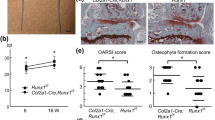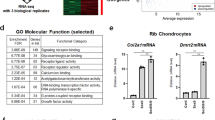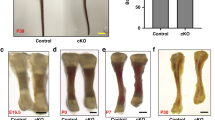Abstract
During endochondral ossification, a process that accounts for the majority of bone formation in vertebrates, hypertrophic chondrocytes display a greater susceptibility to apoptosis when compared to proliferating chondrocytes. However, the molecular mechanisms underlying this phenomenon remain unclear. Nkx3.2, a member of the NK class of homeoproteins, is initially expressed in chondrogenic precursor cells, and later, during cartilage maturation, its expression is restricted to proliferating chondrocytes. Here, we show that the nuclear factor kappa B (NF-κB) pathway is required for chondrocyte viability and that Nkx3.2 supports chondrocyte survival by constitutively activating RelA. Although signal-dependent NF-κB activation has been intensively studied, ligand-independent NF-κB activation is poorly understood. The data presented here support a novel ligand-independent mechanism of NF-κB activation, whereby Nkx3.2 recruits the RelA–IκBα heteromeric complex into the nucleus by direct protein–protein interactions and activates RelA through proteasome-dependent IκBα degradation in the nucleus. Furthermore, we demonstrate that stage-specific NF-κB activation, mediated by Nkx3.2, regulates chondrocyte viability during cartilage maturation.
This is a preview of subscription content, access via your institution
Access options
Subscribe to this journal
Receive 12 print issues and online access
$209.00 per year
only $17.42 per issue
Buy this article
- Purchase on Springer Link
- Instant access to full article PDF
Prices may be subject to local taxes which are calculated during checkout







Similar content being viewed by others
References
Meffert, M. K. & Baltimore, D. Physiological functions for brain NF-κB. Trends Neurosci. 28, 37–43 (2005).
Li, Q., Withoff, S. & Verma, I. M. Inflammation-associated cancer: NF-κB is the lynchpin. Trends Immunol, 26, 318–325 (2005).
Bonizzi, G. & Karin, M. The two NF-κB activation pathways and their role in innate and adaptive immunity. Trends Immunol. 25, 280–288 (2004).
Hayden, M. S. & Ghosh, S. Signaling to NF-κB. Genes Dev. 18, 2195–2224 (2004).
Chen, L. F. & Greene, W. C. Shaping the nuclear action of NF-κB. Nature Rev. Mol. Cell Biol. 5, 392–401 (2004).
Schmitz, M. L., Mattioli, I., Buss, H. & Kracht, M. NF-κB: a multifaceted transcription factor regulated at several levels. Chembiochem 5, 1348–1358 (2004).
Lefebvre, V. & Smits, P. Transcriptional control of chondrocyte fate and differentiation. Birth Defects Res. C. Embryo Today 75, 200–212 (2005).
de Crombrugghe, B., Lefebvre, V. & Nakashima, K. Regulatory mechanisms in the pathways of cartilage and bone formation. Curr. Opin. Cell Biol. 13, 721–727 (2001).
Yang, X. & Karsenty, G. Transcription factors in bone: developmental and pathological aspects. Trends Mol. Med. 8, 340–345 (2002).
Kronenberg, H. M. Developmental regulation of the growth plate. Nature 423, 332–336 (2003).
Gibson, G. Active role of chondrocyte apoptosis in endochondral ossification. Microsc. Res. Tech. 43, 191–204 (1998).
Vortkamp, A. Interaction of growth factors regulating chondrocyte differentiation in the developing embryo. Osteoarthritis Cartilage 9, S109–S117 (2001).
Tribioli, C. & Lufkin, T. Molecular cloning, chromosomal mapping and developmental expression of BAPX1, a novel human homeobox-containing gene homologous to Drosophila bagpipe. Gene 203, 225–233 (1997).
Murtaugh, L. C., Zeng, L., Chyung, J. H. & Lassar, A. B. The chick transcriptional repressor Nkx3.2 acts downstream of Shh to promote BMP-dependent axial chondrogenesis. Dev. Cell 1, 411–422 (2001).
Zeng, L., Kempf, H., Murtaugh, L. C., Sato, M. E. & Lassar, A. B. Shh establishes an Nkx3.2/Sox9 autoregulatory loop that is maintained by BMP signals to induce somitic chondrogenesis. Genes Dev. 16, 1990–2005 (2002).
Kim, D. W. & Lassar, A. B. Smad-dependent recruitment of a histone deacetylase/Sin3A complex modulates the bone morphogenetic protein-dependent transcriptional repressor activity of Nkx3.2. Mol. Cell Biol. 23, 8704–8717 (2003).
Yoshiura, K. I. & Murray, J. C. Sequence and chromosomal assignment of human BAPX1, a bagpipe-related gene, to 4p16.1: a candidate gene for skeletal dysplasia. Genomics 45, 425–428 (1997).
Church, V. et al. Expression and function of Bapx1 during chick limb development. Anat. Embryol. (Berl) 209, 461–469 (2005).
Provot, S. et al. Nkx3.2/Bapx1 acts as a negative regulator of chondrocyte maturation. Development 133, 651–662 (2006).
Atsumi, T., Miwa, Y., Kimata, K. & Ikawa, Y. A chondrogenic cell line derived from a differentiating culture of AT805 teratocarcinoma cells. Cell Differ. Dev. 30, 109–116 (1990).
Shukunami, C., Ohta, Y., Sakuda, M. & Hiraki, Y. Sequential progression of the differentiation program by bone morphogenetic protein-2 in chondrogenic cell line ATDC5. Exp. Cell Res. 241, 1–11 (1998).
Lettice, L. A. et al. The mouse bagpipe gene controls development of axial skeleton, skull, and spleen. Proc. Natl Acad. Sci. USA 96, 9695–9700 (1999).
Akazawa, H. et al. Targeted disruption of the homeobox transcription factor bapx1 results in lethal skeletal dysplasia with asplenia and gastroduodenal malformation. Genes Cells 5, 499–513 (2000).
Tribioli, C. & Lufkin, T. The murine Bapx1 homeobox gene plays a critical role in embryonic development of the axial skeleton and spleen. Development 126, 5699–5711 (1999).
Birbach, A. et al. Signaling molecules of the NF-κB pathway shuttle constitutively between cytoplasm and nucleus. J. Biol. Chem. 277, 10842–10851 (2002).
Hu, C. D., Chinenov, Y. & Kerppola, T. K. Visualization of interactions among bZIP and Rel family proteins in living cells using bimolecular fluorescence complementation. Mol. Cell 9, 789–798 (2002).
Kim, D. W., Kempf, H., Chen, R. E. & Lassar, A. B. Characterization of Nkx3.2 DNA binding specificity and its requirement for somitic chondrogenesis. J. Biol. Chem. 278, 27532–27539 (2003).
Tsukahara, T. et al. Induction of Bcl-x(L) expression by human T-cell leukemia virus type 1 Tax through NF-κB in apoptosis-resistant T-cell transfectants with Tax. J. Virol. 73, 7981–7987 (1999).
Beg, A. A., Sha, W. C., Bronson, R. T., Ghosh, S. & Baltimore, D. Embryonic lethality and liver degeneration in mice lacking the RelA component of NF-κB. Nature 376, 167–170 (1995).
Gerondakis, S., Grossmann, M., Nakamura, Y., Pohl, T. & Grumont, R. Genetic approaches in mice to understand Rel/NF-κB and IκB function: transgenics and knockouts. Oncogene 18, 6888–6895 (1999).
Kanegae, Y., Tavares, A. T., Izpisua Belmonte, J. C. & Verma, I. M. Role of Rel/NF-κB transcription factors during the outgrowth of the vertebrate limb. Nature 392, 611–614 (1998).
Kim, D. W., Cheriyath, V., Roy, A. L. & Cochran, B. H. TFII-I enhances activation of the c-fos promoter through interactions with upstream elements. Mol. Cell Biol. 18, 3310–3320 (1998).
Acknowledgements
This work was supported in part by Korea Research Foundation Grants funded by the Korean Government Basic Research Promotion Fund; KRF-2004-003-C00143, KRF-2005-070-C00091) and by the Science Research Center/Engineering Research Center (SRC/ERC) programme of the Ministry of Science and Technology/Korea Science and Engineering foundation (MOST/KOSEF; R112000078020020).
Author information
Authors and Affiliations
Corresponding author
Ethics declarations
Competing interests
The authors declare no competing financial interests.
Supplementary information
Supplementary Information
Supplementary figures S1, S2, S3 and S4 (PDF 1767 kb)
Rights and permissions
About this article
Cite this article
Park, M., Yong, Y., Choi, SW. et al. Constitutive RelA activation mediated by Nkx3.2 controls chondrocyte viability. Nat Cell Biol 9, 287–298 (2007). https://doi.org/10.1038/ncb1538
Received:
Accepted:
Published:
Issue Date:
DOI: https://doi.org/10.1038/ncb1538
This article is cited by
-
The role of apoptosis in the pathogenesis of osteoarthritis
International Orthopaedics (2023)
-
Histone deacetylase (HDAC) 9: versatile biological functions and emerging roles in human cancer
Cellular Oncology (2021)
-
Runx1 contributes to articular cartilage maintenance by enhancement of cartilage matrix production and suppression of hypertrophic differentiation
Scientific Reports (2019)
-
Biphasic regulation of chondrocytes by Rela through induction of anti-apoptotic and catabolic target genes
Nature Communications (2016)
-
In vivo genome-wide analysis of multiple tissues identifies gene regulatory networks, novel functions and downstream regulatory genes for Bapx1 and its co-regulation with Sox9 in the mammalian vertebral column
BMC Genomics (2014)



